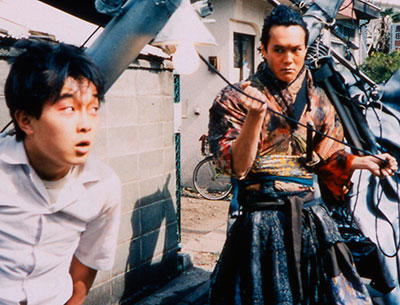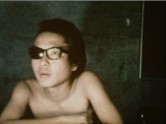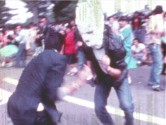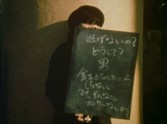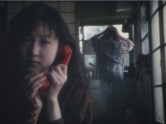Audio transcription
Alexander Zahlten 0:01
Hello everyone. I'm Alexander Zahlten from the Department of East Asian Languages and Civilizations. Sadly you don't have Haden Guest here tonight to greet you and to introduce the retrospective with his usual eloquence, but I'll do my best to say a few words about the background of these films. And I’ll try to keep it fairly short because I know you fought the drizzle to get here, so you're certainly more interested in the films themselves.
The series is called “Hachimiri Madness.” “Hachimiri” means “eight millimeter” in Japanese. And these are a group of films that were digitized, that are from the archives of the PIA Film Festival, which played a very, very central role for Japanese cinema since the since the 1970s, as providing one of the main training grounds for new directors. Probably most of the directors that are well known outside of Japan today actually began their career shooting films that were shown at the PIA Film Festival. The PIA Film Festival focused on films that were in Japan called jishu eiga, jishu films. And jishu is sometimes translated as “independent” film, but it's more accurately probably translated as “autonomous” film. And these are basically films shot by individuals and by small groups of people getting together to shoot films completely outside of any commercial context. So differently from how independent film is understood often in the US, which is still a commercial enterprise of sorts. This was not the case for jishu film. Of course, eight millimeter film production or small gauge film production has existed for a long time in Japan. Astonishingly, actually, there's a very rich history early on. In the 1920s already, certain political groups used 9.5 millimeter film for activism—shooting demonstrations and funerals of deceased or labor activists that had been assassinated and showed these around the country. But there's also an active film scene of individuals shooting films and a very broad span of things. There's an archive in Niigata, in Japan that collects films from locals that were shot in the 1920s, 1930s, and there are fake documentaries and propaganda films and feature films and very bizarre experimental films at a time when actually there was no real sense of what an experimental film in that sense was in Japan yet.
So we find that kind of moving on, of course, interrupted by the war, but in the late 60s, then resurging with a real vengeance. And the reason is that in 1965, Fuji publishes the Fujica Single 8 camera and film cartridge, which is a competitor with Super 8 from Kodak. And what happens is that these cameras that are marketed to the upper middle class, sell fairly well, and are used mainly for shooting home movies. And about five years after that, around 1970, a lot of the people that initially bought these cameras, decide they want new models, or they decided they aren't actually using these cameras enough, so they sell them to secondhand camera stores, and then they become available very cheaply to a much broader part of the population. And then these kinds of cameras really proliferate, and a type of filmmaking takes off that really has no—in its quantity—no equivalents anywhere in the world, I think. So by the mid 1970s we have dozens, to even sometimes hundreds, of films a year: feature films, experimental films, all kinds of films being produced and distributed in a completely alternative distribution network and shown all over the country. And especially young people, students, university students, flock to these films.
So this is something I wrote about in the introduction for the website, but Ishi Sogo, one of whose films are in this retrospective as well, shot a film when he was seventeen, called Panic in High School, a sixteen-minute, eight millimeter film. It was an immense success in the jishu film circuit. So much so that the major studio Toei actually offered him to remake the film as a 35 millimeter ninety-minute feature film. As a director that's unimaginable around that time in the US. Imagine an eighteen-year-old shooting an eight millimeter film, sixteen minutes long, and Universal Studios saying, “That's fantastic. Shoot that as a big budget studio film.” Now, times have changed and now it's much more possible to imagine something like that. At the time, this was absolutely incredible and unprecedented.
So in the mid to late 70s, the PIA Film Festival is established as one of the main venues where a lot of these films were shown and very famous film directors took note and served in the jury. And again, an entire generation of filmmakers tried out their first steps within the jishu scene, which was not, in that sense, an amateur film scene. That's the English term that is often used, and it's not really the right expression, I think, because these films are not amateurish. They are raw often, but they're incredibly sophisticated at other times. They're very aware of the film environment. They're very well schooled as film viewers. Today is kind of the wacky section of this retrospective. Other films are quite reminiscent of French New Wave films. Often kind of ironic, self reflexive comedies of sorts, kind of experimental thrillers. You'll see a whole range of films in this series.
But generally, these films were shown at the PIA Film Festival, which then eventually started to offer money to the main prize winner to produce an actual feature film to be distributed to theaters through professional film or commercial film distribution. So that opened up a window for filmmakers like Kurosawa Kiyoshi, Yamamoto Masashi, Ishi Sogo, Tsukamoto Shinya and others, to become professional professionals in the film industry. Many did not go on to become professional filmmakers. They continued to work within the jishu film scene. But there's an entire generation—and most of the directors known outside of Japan—that come out of exactly that scene. And you'll see that the films have an incredible kind of unbridled energy that even in today's jishu film scene is not present in that same forum. So it's kind of an extraordinary time, I think, in Japanese film history. And a very, very interesting time in world film history actually, as well.
So the films we're seeing tonight are The Adventures of Denchu-Kozo by Tsukamoto Shinya. Some who recently saw Martin Scorsese’s Silence saw Tsukamoto his acting in the film. You may know his film Tetsuo that's kind of the film that he shot after, that became his big breakthrough success on the international film circuit. A very, very established director of course, and Sono Sion again, one of the one of the best known names in Japanese film today. And even today, he's kind of known as a provocateur, someone who doesn't stick to the rules, and you'll see in this film as well, he's fascinated by the borderline between fiction and reality and how the camera plays into that. That's a common obsession among jishu films. If you come to several films in the series, you'll encounter that again and again, that there's a fascination with that switch between when something becomes is seen as fictional when it suddenly becomes real, and sometimes too real and uncomfortable. And Sono Sion's film is certainly a good example of that as well.
So I'll leave it at that. I don't know, maybe at some point later in the retrospective, I'll come by again and say a bit more about how jishu film developed in a more particular form, but for now, I have a lot of fun with tonight's opening. Thank you.
[APPLAUSE]
©Harvard Film Archive



